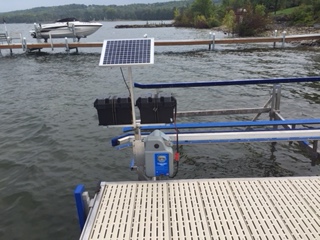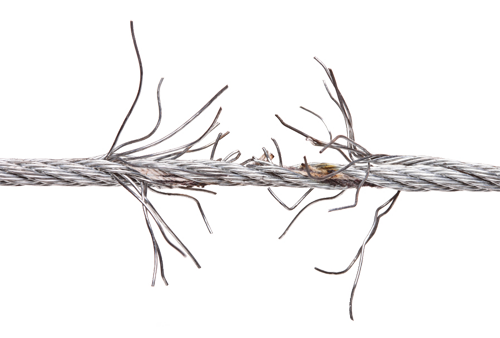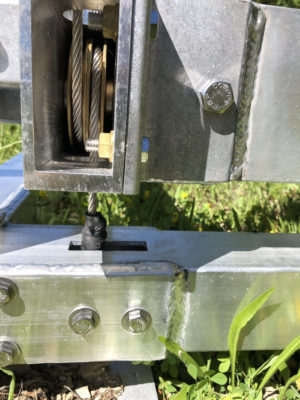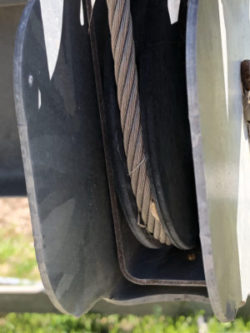BOAT LIFT SELECTION
Purchasing a boat lift (new or used) can be very confusing. There is a lot to consider before making your selection. This article will assist you in making the right decision.
Let’s start with, where will you be using the boat lift?
Why is location important? The location will be an essential consideration for determining the suitability of a boat lift for the body of water you are on. Will you be on the Bay of Green Bay, Lake Winnebago, a river or a small inland lake?
On larger bodies of water, vertical boat lifts are the preferred choice. Why? The answer is the extra lifting height you get versus a cantilever lift.
2019 is proving to be a challenging year for most dock and boat lift owners. With record-setting water depths and strong, frequent storms, owners see the need for the higher lifting capacities.
Unlike people on small lakes, the Bay of Green Bay and Lake Winnebago present unique problems for boaters. The reasons are the storm surges. A storm surge is caused by sustained winds blowing in one direction with no rivers or creeks on the leeward side to relieve the pressure of the water piling up. Wave action of 4 or more feet on top of a water surge makes the situation even worse.
These two factors combined, mean you will need a lift that raises high enough to keep your investment from being damaged. You also need the most durable frame construction possible.
Frame strength is achieved by using a more substantial square or rectangular frame versus a round, thin tube. If the frame is not strong enough, you won’t get the extra protection your boat deserves. That’s why PWS only handles ShoreMaster boat lifts.
Rivers have unique problems in the form of fluctuations in water depth in early spring from snow melting and heavy rain runoff during the season. Any boat lift must be capable of handling the changing water levels here too.
Depth of water is another consideration.
Vertical lifts, with a “V” rack, require about 6″ of water plus the draft of the boat to operate. This low water requirement is vital if the water recedes in late summer or fall.
Boat length, width, and weight affect your choice.
PWS recommends that you consider not only the length, width, and weight of the boat you currently have, but also the possibility of a larger boat in the future. It will save you money in the long run. People frequently change to a bigger, better boat, so you should not ignore this issue.
Why do we insist on checking the weight you give us for your boat?
It’s not that we don’t trust you – we simply don’t trust you, but in a good way. Our reputation is on the line with every lift we sell, so it has to be the right one for your needs. Some salespeople quickly choose the lift you “need” without even looking up the Specifications to be sure. Remember, the weight is more than the boat weight.
See also https://wisconsinpws.com/boat-lift-calculations-part-4/
Will you raise the boat by hand or do you need a motor?
Do you want to raise your boat with the winch wheel or use a remote-controlled motor to do the work for you? 12V/24V D.C. motors power most boat lifts with 120V A.C. used less frequently.
A.C. versions, while available, require 120 V power at the boat site and require more care to prevent electrical shock.
What are the Frame Materials?
The most popular boat lifts in N.E. Wisconsin have aluminum frames and stainless steel cables.
There are still a few steel boat lifts around.
But they are few and far between due to their weight, limited lifting heights and susceptibility to rust.
Aluminum boat lifts will have either galvanized or stainless steel cables. Sometimes they have a combination of both materials. Stainless steel cables last as much as 2-4 times longer than galvanized steel cables and don’t rust.
What about the pulleys on the lift?
Pulleys on boat lifts will be either plastic, steel or brass construction. Robust brass pulleys with stainless steel hubs are
the best choice while plastic pulleys are not recommended even on the lighter PWC lifts. The heavier the boat, the more critical it is to have stainless steel and brass materials.
Plastic pulleys become brittle over time. Eventually, the edges break off, and the cable gets jammed between the frame and the pulley. Raising a boat with a jammed cable is extremely hard to do.
Who will install the boat lift?
A professional company is best suited to do this for you.
Boat lifts in the 5000# range or larger, definitely require professional installation and removal services. It’s not a job for amateurs. Do you have a dependable provider for this service? PWS has experienced, trained people and the necessary equipment to do it for you,
What is the Warranty?
Many boat lifts come with a 1 or 2-year factory structural warranty. Some have five-year, and a few even have a 10-year warranty. ShoreMaster boat lifts carry a full 15-year structural warranty. The 15-year warranty is the best on the market.
SEE https://shoremasteravala.blob.core.windows.net/media/1588/shoremaster-warranty-12142016.pdf
Now it’s up to you! Our recommendation? See what your neighbors have to say about PWS.
Do you have a friend that might be interested in this post? Please forward it to them.
Pier & Waterfront Solutions
PWS is located at 7325 St. Hwy 57. That’s 1 mile North of County MM (Hwy 42) and 3 miles south of Sturgeon Bay at the Idlewild Road intersection. Or – for more information, you can call Jerry @ 920-493-4404.











